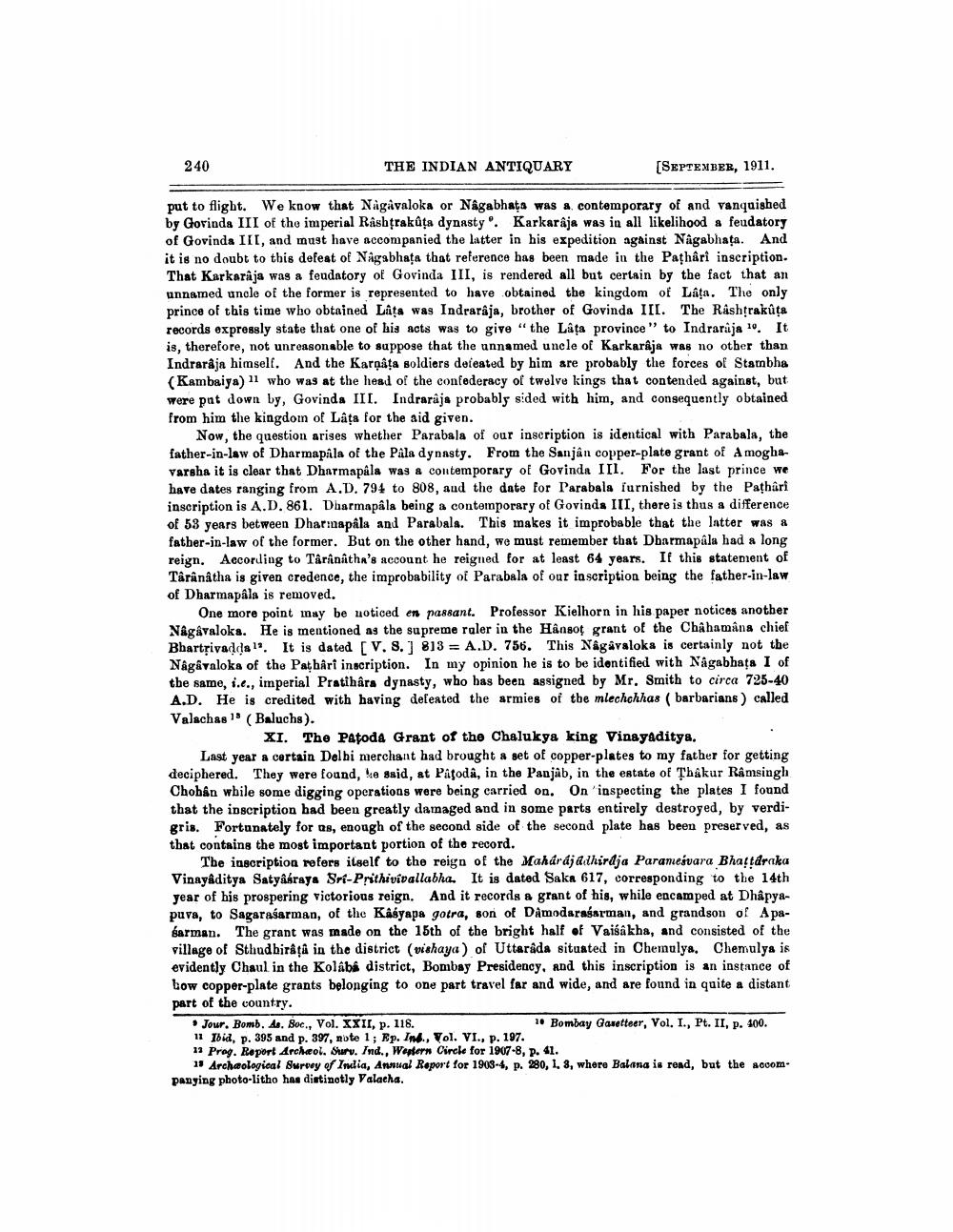________________
THE INDIAN ANTIQUARY
[SEPTEMBER, 1911.
put to flight. We know that Nagavaloka or Nagabhata was a contemporary of and vanquished by Govinda III of the imperial Rashtrakuta dynasty". Karkaraja was in all likelihood a feudatory of Govinda III, and must have accompanied the latter in his expedition against Nagabhata. And it is no doubt to this defeat of Nagabhața that reference has been made in the Pathârî inscription. That Karkaraja was a feudatory of Govinda III, is rendered all but certain by the fact that an unnamed uncle of the former is represented to have obtained the kingdom of Lâța. The only prince of this time who obtained Lâts was Indrarâja, brother of Govinda III. The Rashtrakuta records expressly state that one of his acts was to give "the Lâța province" to Indraraja 10. It is, therefore, not unreasonable to suppose that the unnamed uncle of Karkaraja was no other than Indraraja himself. And the Karpâța soldiers defeated by him are probably the forces of Stambha (Kambaiya) 11 who was at the head of the confederacy of twelve kings that contended against, but were put down by, Govinda III. Indraraja probably sided with him, and consequently obtained from him the kingdom of Lâța for the aid given.
Now, the question arises whether Parabala of our inscription is identical with Parabala, the father-in-law of Dharmapala of the Pâla dynasty. From the Sanjân copper-plate grant of Amoghavarsha it is clear that Dharmapâla was a contemporary of Govinda III. For the last prince we have dates ranging from A.D. 794 to 808, and the date for Parabala furnished by the Pathari inscription is A.D. 861. Dharmapâla being a contemporary of Govinda III, there is thus a difference of 53 years between Dharmapala and Parabala. This makes it improbable that the latter was a father-in-law of the former. But on the other hand, we must remember that Dharmapâla had a long reign. According to Târânâtha's account he reigned for at least 64 years. If this statement of Târânâtha is given credence, the improbability of Parabala of our inscription being the father-in-law of Dharmapâla is removed.
One more point may be noticed en passant. Professor Kielhorn in his paper notices another Nagavaloka. He is mentioned as the supreme raler in the Hânsot grant of the Châhamâna chief Bhartṛivadda. It is dated [V. S. ] 813 A.D. 756. This Nagavaloka is certainly not the Nagavaloka of the Pathârî inscription. In my opinion he is to be identified with Nagabhata I of the same, i..., imperial Pratihâra dynasty, who has been assigned by Mr. Smith to circa 725-40 A.D. He is credited with having defeated the armies of the mlechchhas (barbarians) called Valachas 1 (Baluchs).
XI. The Patoda Grant of the Chalukya king Vinayaditya.
240
Last year a certain Delhi merchant had brought a set of copper-plates to my father for getting deciphered. They were found, he said, at Pâtodâ, in the Panjab, in the estate of Thakur Ramsingh Chohan while some digging operations were being carried on. On 'inspecting the plates I found that the inscription had been greatly damaged and in some parts entirely destroyed, by verdigris. Fortunately for us, enough of the second side of the second plate has been preserved, as that contains the most important portion of the record.
The inscription refers itself to the reign of the Maharajadhiraja Parameśvara Bhattaraka Vinayâditya Satyaáraya Sri-Prithivivallabha. It is dated Saka 617, corresponding to the 14th year of his prospering victorious reign. And it records a grant of his, while encamped at Dhâpyapuva, to Sagaraśarman, of the Kasyapa gotra, son of Damodarasarman, and grandson of Apaéarman. The grant was made on the 15th of the bright half of Vaisakha, and consisted of the village of Sthudhirâțâ in the district (vishaya) of Uttarâda situated in Chemulys. Chemulys is evidently Chaul in the Kolâbâ district, Bombay Presidency, and this inscription is an instance of how copper-plate grants belonging to one part travel far and wide, and are found in quite a distant part of the country.
Jour. Bomb. As. Soc., Vol. XXII, p. 118.
11 Ibid, p. 395 and p. 397, note 1; Ep. Ind., Vol. VI., p. 197.
13 Prog. Report Archeol. Surv. Ind., Western Circle for 1907-8, p. 41.
10 Bombay Gasetteer, Vol. I., Pt. II, p. 400.
1 Archeological Survey of India, Annual Report for 1903-4, p. 280, 1, 3, where Balana is read, but the accompanying photo-litho has distinctly Valacha.




